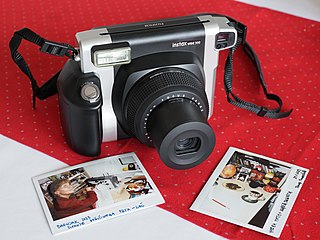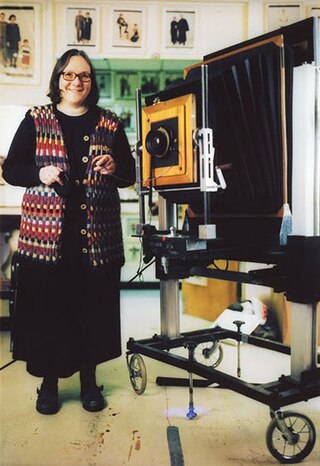
A camera is an instrument used to capture and store images and videos, either digitally via an electronic image sensor, or chemically via a light-sensitive material such as photographic film. As a pivotal technology in the fields of photography and videography, cameras have played a significant role in the progression of visual arts, media, entertainment, surveillance, and scientific research. The invention of the camera dates back to the 19th century and has since evolved with advancements in technology, leading to a vast array of types and models in the 21st century.

A folding camera is a camera type. Folding cameras fold into a compact and rugged package for storage. The lens and shutter are attached to a lens-board which is connected to the body of the camera by a light-tight folding bellows. When the camera is fully unfolded it provides the correct focus distance from the film. The key advantage of folding cameras is their excellent physical-size to film-size ratio when the camera is folded for storage.

Edwin Herbert Land, ForMemRS, FRPS, Hon.MRI was an American scientist and inventor, best known as the co-founder of the Polaroid Corporation. He invented inexpensive filters for polarizing light, a practical system of in-camera instant photography, and the retinex theory of color vision, among other things. His Polaroid instant camera went on sale in late 1948 and made it possible for a picture to be taken and developed in 60 seconds or less.

Polaroid Corporation was an American company best known for its instant film and cameras, which now survives as a brand for consumer electronics. The company was founded in 1937 by Edwin H. Land, to exploit the use of his Polaroid polarizing polymer. Land and Polaroid created the first instant camera, the Land Camera, in 1948.

The Land Camera is a model of self-developing film camera manufactured by Polaroid between 1948 and 1983. It is named after the inventor, American scientist Edwin Land, who developed a process for self-developing photography between 1943 and 1947. After Edwin Land's retirement from Polaroid in 1982, the name 'Land' was dropped from the camera name. The first commercially available model was the Model 95, which produced sepia-colored prints in about 1 minute. It was first sold to the public on November 26, 1948.

An instant camera is a camera which uses self-developing film to create a chemically developed print shortly after taking the picture. Polaroid Corporation pioneered consumer-friendly instant cameras and film, and were followed by various other manufacturers.

The Holga is a medium format 120 film camera, made in Hong Kong, known for its low-fidelity aesthetic.

Instant film is a type of photographic film that was introduced by Polaroid Corporation to produce a visible image within minutes or seconds of the photograph's exposure. The film contains the chemicals needed for developing and fixing the photograph, and the camera exposes and initiates the developing process after a photo has been taken.

An autofocus optical system uses a sensor, a control system and a motor to focus on an automatically- or manually-selected point or area. An electronic rangefinder has a display instead of the motor; the adjustment of the optical system has to be done manually until indication. Autofocus methods are distinguished as active, passive or hybrid types.

The SX-70 is a folding single lens reflex Land camera which was produced by the Polaroid Corporation from 1972 to 1981. The SX-70 helped popularize instant photography.

The history of the single-lens reflex camera (SLR) begins with the use of a reflex mirror in a camera obscura described in 1676, but it took a long time for the design to succeed for photographic cameras. The first patent was granted in 1861, and the first cameras were produced in 1884, but while elegantly simple in concept, they were very complex in practice. One by one these complexities were overcome as optical and mechanical technology advanced, and in the 1960s the SLR camera became the preferred design for many high-end camera formats.

The Polaroid Model 20 "Swinger" was a popular Land Camera produced by the Polaroid Corporation between July 1965 and 1970. At $19.95 and weighing only 21 ounces (600 g), it was the first truly inexpensive instant camera, a fact that helped fuel its enormous popularity and made it one of the top-selling cameras of all time. The Swinger was especially successful in the youth market due to its low price, stylish appearance, catchy Meet the Swinger jingle, as well as getting the camera into drugstores. In fact, it was so successful that it became Polaroid's best selling product at the time, and increased their share in the new camera market.

The Minolta A-mount camera system was a line of photographic equipment from Minolta introduced in 1985 with the world's first integrated autofocus system in the camera body with interchangeable lenses. The system used a lens mount called A-mount, with a flange focal distance 44.50 mm, one millimeter longer, 43.5 mm, than the previous SR mount from 1958. The new mount was wider, 49.7 mm vs. 44.97 mm, than the older SR-mount and due to the longer flange focal distance, old manual lenses were incompatible with the new system. Minolta bought the autofocus technology of Leica Correfot camera which was partly used on the a-mount autofocus technology. The mount is now used by Sony, who bought the SLR camera division from Konica Minolta, Konica and Minolta having merged a few years before.

Instax is a brand of instant still cameras and instant films marketed by Fujifilm.

Polaroid art is a type of alternative photography which consists of modifying an instant picture, usually while it is being developed. The most common types of Polaroid art are the emulsion lift, the Polaroid transfer and emulsion manipulation.

The Polaroid Impulse is a camera produced by Polaroid Corporation between 1988 and 1994. The camera uses Polaroid's 600-series integral film. The Impulse is distinguished from Polaroid's other 600-series cameras by its always-on flash, binocular-style grips, larger viewfinder, and self-timer.

The Polaroid 20×24 camera is a very large instant camera made by Polaroid, with film plates that measure a nominal 20 by 24 inches, giving the camera its name, although at least one camera takes pictures that are 23 by 36 inches.

Polaroid B.V. is a Dutch photography and consumer electronics company, founded as a manufacturer of discontinued film for Polaroid Corporation instant cameras. The company produces new instant cameras under the Polaroid brand name as well as wireless speakers and other accessories.
MiNT Camera is a company specializing in instant cameras and its accessories. Founded in 2009, it provides products and services related to instant photography. MiNT Camera has partnered with Impossible Project, now Polaroid, a manufacturer of instant photographic materials. MiNT is a well-established player in the instant photo market.


















